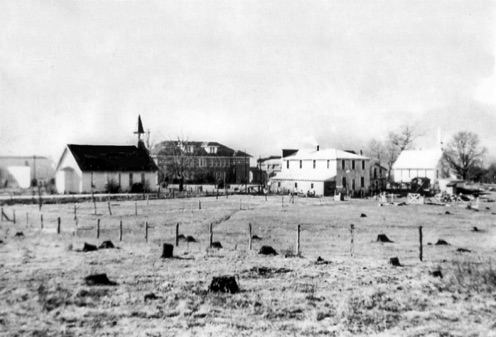About the Bethel Community

Bethel Community - 1950s
The picture to the left shows the "heart" of Bethel in the 1950s. Bethel Presbyterian Church is to the left. All of the other buildings are no longer with us. Bethel school is in the background; the backside of J.B. Rigdon General Store is in the foreground; the Bethel Baptist Church is to the right.
- Bethel is the location of the oldest human settlement (8,000 BC) and the oldest white settlement (1785) in Haywood County, North Carolina - dating prior to Haywood County's establishment date of 1808.
- The Blue Ridge Parkway, Pisgah National Forest, Mount Pisgah, Black Balsam, Cold Mountain, thirteen miles of pristine streams, and farmland-rich alluvial soils provide significant natural backdrop features to enhance the landscape of Bethel Community.
- The name “Bethel,” meaning house of God, derives from religious camp meetings that were common in the area during the early to mid-nineteenth century. Camp meetings provided religious indoctrination but also enabled participants to experience an important social component to their busy rural existence.
- Bethel’s original Native American name, “Sonoma,” means “valley of the moon” or “earth village.” Sonoma Road still bears the legacy of the original Native American name for the community.
- An early alternate name for Bethel, “Forks of Pigeon,” like today's alternate Bethel name, "Pigeon Valley," relies on the prominent association the community has had with the passenger pigeon. Billions of now extinct passenger pigeons once traveled through the community on their annual migration route, leaving their legacy with several local names: Pigeon Community, Pigeon Gap, Pigeon River, Pigeon Street, and Pigeon Valley.
- Another name for Bethel that is listed on maps is “Woodrow." Beginning in the late 1800s the Western North Carolina mountains provided raw material to feed the burgeoning logging and paper industry. Trains and railway lines accompanied the development of these commercial ventures. The nearby logging village known as “Sunburst” became connected to Champion Fiber, a paper plant in nearby Canton, via the T & NC Railroad. By 1914 the rail company located a depot and post office in Bethel and named it for President Woodrow Wilson. That name is the one listed on maps, even though many people living in Bethel have not ever called the community by its Woodrow name. The train depot and post office were dismantled in 1927, and the rail lines were removed by 1933, but the name has lingered.
- A final name associated with Bethel is “Cold Mountain.” The name “Bethel” may not have suited author, Charles Frazier, as haunting enough or exuding a sufficient amount of melancholy, reverie, or mystery to be an appropriate title for his 1997 National Book Award and Academy Award nominated movie, Cold Mountain. Frazier's protagonist, Inman, however, is based on Frazier's real-life ancestor who was born, lived, murdered, and buried in Bethel in the vicinity of distant Cold Mountain.
- Today, Bethel Community is home to Bethel Elementary and Bethel Middle Schools, two fire departments, numerous churches, dozens of businesses, protected farm and rural lands, a lovely river, scenic vistas, historic sites, and approximately 3,500 people.